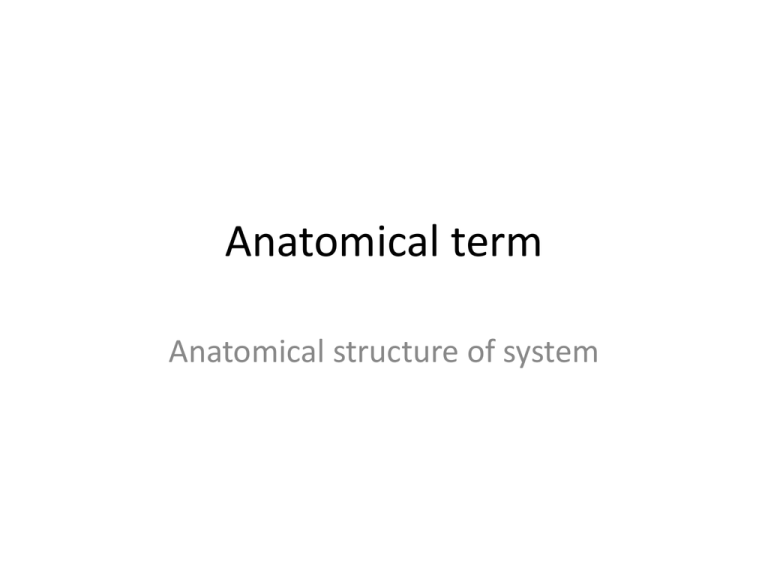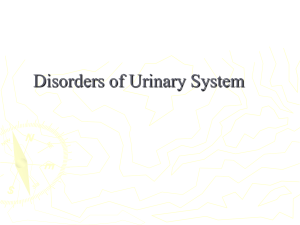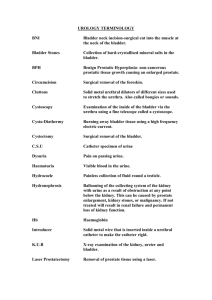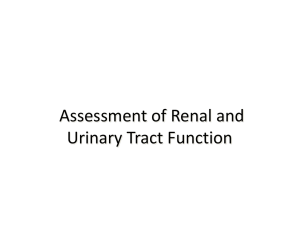
Anatomical term
Anatomical structure of system
Objectives
• Name and locate the anatomical structures of
the urinary system, the female reproductive
system and the adrenal glands.
• Use medical terminology to describe
conditions and procedures related to these
organs and systems.
Urinary System
• The organs of the urinary system are the
kidneys, ureters, bladder and urethra.
• The urinary system removes soluble nitrogen
west from the bloodstream and excretes it as
urine.
• Identify the parts of the urinary system and
learn the roots that refer to them in medical
terms and the meaning of the terms.
Body part Root and
combining
vowel
Definition
Kidney
Nephr(o)-, ren(o)
Organs that process urine
Renal pelvis
Pyel(o)
Collecting basin for urine from the collecting
ducts of the kidney.
Ureters
Ureter(o)
A duct through which urine is carried from
the renal pelvis to the bladder.
Urinary
bladder
Cyst(o)
Expandable sac that stores urine before it’s
eliminated by urination.
Prostate
Prostat(o)
A gland in the male urinary tract.
Inflammation of the prostate gland commonly
causes obstruction of urine flow.
Urethra
Urethr(o)
The outlet for urine flow. Because the urethra
is much shorter in females, they are more
susceptible to urinary tract infections (UTI).
Urinary system
Adrenal glands
(Nephr(o),
ren(o))
(Ureter(o))
Cyst(o)
(Urethr(o))
Renal pelvis
(Pyel(o))
Adrenal glands
• The adrenal glands, a part of the endocrine
system, secrete a group of hormones that
profoundly influence all body systems.
• The anatomical placement of the adrenal
glands are sometimes called the suprarenal
glands, and the term adrenal it’s component
parts Ad/renal – means toward the kidney.
Disorders, and procedures
• Pyelonephritis is an inflammation of the kidneys
and renal pelvis. Associated with formation of
small abscess in the renal pelvis.
Treatment consists of antibiotics and surgical
correction of any obstruction to urine flow.
• Urine retention results from blockage of urine
flow from the bladder.
• Urinary incontinence is the inability to control
urine flow from the bladder.
Disorders, and procedures
CysTOScopy
Visual examination of the urinary bladder
UreTHRItis
Inflammation of the urethra
UreterItis
Inflammation of the ureter
PyeLItis
Inflammation of the renal pelvis or kidney
basin
UreTHROStomy
Forming a new opening in the urethra
UreterolithOTomy
Surgical incision into the ureter to remove a
calculus or stone.
CYSTocele
Herniation of the urinary bladder
UreterocysTOStomy Forming a new opening in the urinary bladder
and ureter
Female reproductive system
• The female reproductive system consists of
organs that produce ova and female sex cells
and provide for the growth of the embryo.
• Identify the major parts of the female
reproductive system and learn the roots used
to describe them.
Major parts of the female
reproductive system
Body part
Fallopian tube
Ovary
Uterus
Vagina
Root and combining vowel
Salping(o)
Oophor(o), Ovary(o)
Hyster(o), Metr(o)
Colp(o)
Descriptive prefixes
Prefix
Meaning
ambianis(o)euisomacr(o)mon(o)multiscler(o)-
both
unequal
good or normal
equal
large
one
many, much
hard
Anatomical terms
• AmbiOpia – double vision.
• AnisocyTOsis – inequality of the size of cells, especially
erythrocytes.
• EuPEPsia is the opposite of dyspepsia – good or
normal degestion.
• MacroSCOPic is the opposite of microscopic – seen
with the naked eye.
• MONocyte is the largest of the leukocytes – leukocyte
having one nuclei.
• MultiNUclear is several types of white blood cells are
– having many nuclei.
• ScleroDERma is a chronic collagen disease - hardening
of the skin.
Anatomical terms
•
•
•
•
•
•
CheiLOTomy – surgical incision into the lip.
InterCOStal – between the ribs.
DacTYLogram- fingerprint.
HemaTOLogy- study of blood.
HepaTItis – inflammation of the liver.
LapaROTomy – surgical incision into the abdominal
wall.
• LiPOma – fatty tumor
• NarCOsis – condition of being unconscious.
• StenoCARdia – narrow vessels of the heart.
Descriptive prefixes
Suffix
-centesis
Meaning
-emesis
-emia
-lysis
vomiting
-malacia
-penia
plegia
softening
ptosis
prolaps
tripsy
Surgical crushing
uria
urine
Surgical puncture
blood
Destruction, break down, separation
Decrease deficiency, lack of
paralysis
Female reproductive system
CoIPItis
Inflammation of the vagina
Salpingo-oophoRECtomy
Surgical excision of an ovary and a fallopian tube
OvariECtomy
Surgical excision of an ovary
HysterECtomy
Surgical excision of uterus
SalpinGItis
Inflammation of the fallopian tube
VaginItis
Inflammation of the vagina
BiLATeral salpinGECtomy Surgical excision of both fallopian tube
Anatomical terms
• ThoracenTEsis – surgical puncture of the thoracic
cavity.
• HyperEMesis – excessive vomiting.
• LeuKEmia – cancer of the white blood cells.
• HeMOLysis (Snake venoms may cause ) – destruction
of the blood cells.
• OsteomalAcia – softning of bone.
• LeukocytoPEnia – deficiency of the white blood cells.
• HemiPLEgia – paralysis on the left or right side of the
body.
• PolyUria – excessive urination.
Anatomical terms
•
•
•
•
•
•
•
•
•
•
•
•
Cheilitis – inflammation of the lips.
Lipoma – fatty tumor.
Narcotic – drug used to reduce pain and induce sleep.
Eupnea – good or normal breathing.
Ophthalmoplegia – paralysis of the eye muscles.
Monomyositis – inflammation of one musle.
Stenostomia – narroe mouth.
Arteriosclerosis – hardining of the arteries.
Leukocytopenia – lack of white blood cells.
Encephalomalacia – softning 0f the tissus of the brain.
Gastrocentesis - surgical puncture into the stomach.
Hemiplegia – paralysis on the left or right side of the body.












